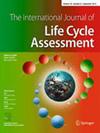Environmental potential of fungal insulation: a prospective life cycle assessment of mycelium-based composites
IF 5.4
3区 环境科学与生态学
Q2 ENGINEERING, ENVIRONMENTAL
引用次数: 0
Abstract
Abstract Purpose Bio-based insulation materials are one of the most promising solutions for reducing the environmental impacts of building envelopes. Among these materials, the environmental benefits of mycelium-based materials have merely been investigated, despite their promising technical and thermal properties. In this paper, we perform a first prospective cradle-to-grave life cycle assessment (LCA) of mycelium-based composite blocks. Methods An attributional cradle-to-gate LCA of the laboratory production of mycelium-based composites was first performed, including 11 environmental impact indicators. Then, scenarios were defined to scale up the technology to the level of industrial production, including the remaining life cycle modules to perform a cradle-to-grave analysis. Biogenic and metabolic carbon were considered by applying the static −1/+1 approach and following the current LCA standards. Future-oriented energy and transport mixes were also included as an additional scenario, systematically modifying both the foreground and background data. Finally, the industrially scaled-up technology and alternative insulation materials were compared with these future conditions (as applied to both materials). Results and discussion Considering climate change, the results are encouraging in comparison to those for traditional plastic insulation, but do not necessarily surpass those for other existing materials such as rock wool. However, trade-offs are observed in other indicators, for which mycelium-based composites tend to perform worse than traditional insulation materials. The industrial scale-up reduced impacts for most indicators, but a considerable trade-off was observed with regard to terrestrial ecotoxicity. The main driver for the remaining greenhouse gas (GHG) emissions was found to be the electricity use during the manufacturing phase. We consider the inclusion of the other life cycle stages as relevant, as this increased the GHG emissions by 10%. Limitations of the current LCA standards, however, are noted and discussed, especially regarding the cascading use of biogenic materials, and highlight the relevance of this case study. Conclusions Mycelium-based composites show a potential for future development, but careful attention should be paid to reducing electricity needs in their manufacturing process. Further improvements could also be made by using fast-growing biogenic materials as a substrate. In particular, we encourage researchers to include all of the life cycle stages in future studies, especially if biogenic emissions are considered.真菌绝缘的环境潜力:菌丝基复合材料的前瞻性生命周期评估
摘要目的生物基保温材料是减少建筑围护结构对环境影响最有前途的解决方案之一。在这些材料中,菌丝体基材料的环境效益仅被研究过,尽管它们具有很好的技术和热性能。在本文中,我们对菌丝体复合块进行了首次前瞻性的从摇篮到坟墓的生命周期评估(LCA)。方法首先对菌丝体基复合材料实验室生产过程进行归因从摇篮到大门的LCA分析,包括11项环境影响指标。然后,定义了将技术扩展到工业生产水平的场景,包括剩余的生命周期模块,以执行从摇篮到坟墓的分析。采用静态- 1/+1方法并遵循当前的LCA标准来考虑生物源碳和代谢碳。面向未来的能源和运输混合也被作为一个额外的情景,系统地修改前景和背景数据。最后,将工业规模扩大的技术和替代绝缘材料与这些未来条件(适用于两种材料)进行比较。考虑到气候变化,与传统的塑料绝缘材料相比,结果令人鼓舞,但不一定超过岩棉等其他现有材料。然而,在其他指标中也观察到权衡,在这些指标中,菌丝体基复合材料的性能往往比传统的绝缘材料差。工业规模的扩大减少了对大多数指标的影响,但在陆地生态毒性方面观察到相当大的权衡。剩余温室气体(GHG)排放的主要驱动因素是制造阶段的电力使用。我们认为包括其他生命周期阶段是相关的,因为这增加了10%的温室气体排放量。然而,指出并讨论了当前LCA标准的局限性,特别是关于生物源材料的级联使用,并强调了本案例研究的相关性。结论菌丝体基复合材料具有广阔的发展前景,但在制备过程中应注意减少耗电量。进一步的改进还可以通过使用快速生长的生物材料作为衬底。我们特别鼓励研究人员在未来的研究中包括所有生命周期阶段,特别是在考虑生物源排放的情况下。
本文章由计算机程序翻译,如有差异,请以英文原文为准。
求助全文
约1分钟内获得全文
求助全文
来源期刊
CiteScore
10.60
自引率
10.40%
发文量
100
审稿时长
8-16 weeks
期刊介绍:
The International Journal of Life Cycle Assessment (Int J Life Cycle Assess) is the first journal devoted entirely to Life Cycle Assessment and closely related methods. LCA has become a recognized instrument to assess the ecological burdens and impacts throughout the consecutive and interlinked stages of a product system, from raw material acquisition or generation from natural resources, through production and use to final disposal. The Int J Life Cycle Assess is a forum for scientists developing LCA and LCM (Life Cycle Management); LCA and LCM practitioners; managers concerned with environmental aspects of products; governmental environmental agencies responsible for product quality; scientific and industrial societies involved in LCA development, and ecological institutions and bodies.

 求助内容:
求助内容: 应助结果提醒方式:
应助结果提醒方式:


